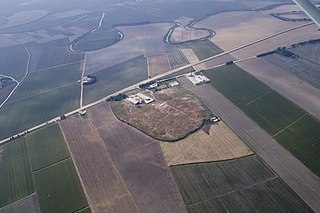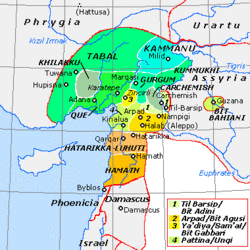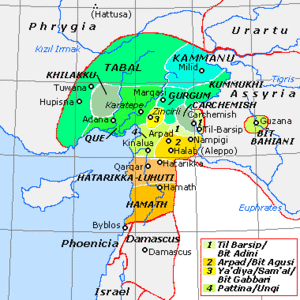
The Hittites were an Anatolian Indo-European people who formed one of the first major civilizations of Bronze Age West Asia. Possibly originating from beyond the Black Sea, they settled in modern day Turkey in the early 2nd millennium BC. The Hittites formed a series of polities in north-central Anatolia, including the kingdom of Kussara, the Kanesh or Nesha kingdom, and an empire centered on Hattusa. Known in modern times as the Hittite Empire, it reached its height during the mid-14th century BC under Šuppiluliuma I, when it encompassed most of Anatolia and parts of the northern Levant and Upper Mesopotamia.

Mitanni, c. 1550–1260 BC, earlier called Ḫabigalbat in old Babylonian texts, c. 1600 BC; Hanigalbat or Hani-Rabbat in Assyrian records, or Naharin in Egyptian texts, was a Hurrian-speaking state with Indo-Aryan linguistic influences in northern Syria and southeast Anatolia. Since no histories, royal annals or chronicles have yet been found in its excavated sites, knowledge about Mitanni is sparse compared to the other powers in the area, and dependent on what its neighbours commented in their texts.
A vassal state is any state that has a mutual obligation to a superior state or empire, in a status similar to that of a vassal in the feudal system in medieval Europe. Vassal states were common among the empires of the Near East, dating back to the era of the Egyptian, Hittite and Mitanni conflict, as well as ancient China. The use of vassal states continued through the Middle Ages, with the last empire to use such states arguably being the Ottoman Empire, though some say that the British Empire had vassal states.

Qatna was an ancient city located in Homs Governorate, Syria. Its remains constitute a tell situated about 18 km (11 mi) northeast of Homs near the village of al-Mishrifeh. The city was an important center through most of the second millennium BC and in the first half of the first millennium BC. It contained one of the largest royal palaces of Bronze Age Syria and an intact royal tomb that has provided a great amount of archaeological evidence on the funerary habits of that period.

Carchemish, also spelled Karkemish, was an important ancient capital in the northern part of the region of Syria. At times during its history the city was independent, but it was also part of the Mitanni, Hittite and Neo-Assyrian Empires. Today it is on the frontier between Turkey and Syria.

Aram was a historical region mentioned in early cuneiforms and in the Bible, populated by Arameans. The area did not develop into a larger empire but consisted of a number of small states in present-day Syria and northern Israel. Some of the states are mentioned in the Old Testament, Damascus being the most outstanding one, which came to encompass most of Syria. Furthermore, Aram-Damascus is commonly referred to as simply Aram in the Old Testament.

Tyana, earlier known as Tuwana during the Syro-Hittite period, and Tuwanuwa under the Hittite Empire, was an ancient city in the Anatolian region of Cappadocia, in modern Kemerhisar, Niğde Province, Central Anatolia, Turkey. It was the capital of a Luwian-speaking Neo-Hittite kingdom in the 1st millennium BC.

Tell Ta'yinat is a low-lying ancient tell on the east bank at the bend of the Orontes River where it flows through the Amuq valley, in the Hatay province of southeastern Turkey about 25 kilometers south east of Antakya, and lies near Tell Atchana, the site of the ancient city of Alalakh. Tell Ta'yinat has been proposed as the site of Alalaḫu, inhabited in late 3rd millennium BC, mentioned in Ebla's Palace G archive; and in later times as Kinalua, the capital city of an Iron Age Neo-Hittite kingdom. Among the findings are an Iron Age temple and several 1st millennium BC cuneiform tablets.

The states called Neo-Hittite, Syro-Hittite, or Luwian-Aramean were Luwian and Aramean regional polities of the Iron Age, situated in southeastern parts of modern Turkey and northwestern parts of modern Syria, known in ancient times as lands of Hatti and Aram. They arose following the collapse of the Hittite New Kingdom in the 12th century BCE, and lasted until they were subdued by the Assyrian Empire in the 8th century BCE. They are grouped together by scholars, on the basis of several cultural criteria, that are recognized as similar and mutually shared between both societies, northern (Luwian) and southern (Aramaean). Cultural exchange between those societies is seen as a specific regional phenomenon, particularly in light of significant linguistic distinctions between the two main regional languages, with Luwian belonging to the Anatolian group of Indo-European languages and Aramaic belonging to the Northwest Semitic group of Semitic languages. Several questions related to the regional grouping of Luwian and Aramaean states are viewed differently among scholars, including some views that are critical towards such grouping in general.
Šuppiluliuma may refer to:
Sangara or Sangar was a king of Carchemish. He belonged to the House of Suhi of Carchemish, and ruled from 870 to 848 BC.

Kummuh was an Iron Age Neo-Hittite kingdom located on the west bank of the Upper Euphrates within the eastern loop of the river between Melid and Carchemish. Assyrian sources refer to both the land and its capital city by the same name. The city is identified with the classical-period Samosata, which has now been flooded under the waters of a newly built dam. Urartian sources refer to it as Kummaha. The name is also attested in at least one local royal inscription dating to the 8th century BCE. Other places that are mentioned in historical sources as lying within Kummuh are lands of Kištan and Halpi, and cities of Wita, Halpa, Parala, Sukiti and Sarita(?). Kummuh bordered the kingdoms of Melid to the north, Gurgum to the west and Carchemish to the south, while to the east it faced Assyria and later Urartu.

The prehistory of Anatolia stretches from the Paleolithic era through to the appearance of classical civilisation in the middle of the 1st millennium BC. It is generally regarded as being divided into three ages reflecting the dominant materials used for the making of domestic implements and weapons: Stone Age, Bronze Age and Iron Age. The term Copper Age (Chalcolithic) is used to denote the period straddling the stone and Bronze Ages.

Luhuti, Lukhuti or Lu'ash, was an Iron Age Syro-Hittite Aramean region during the early 1st millennium BC located in northern Syria, in an area that used to be called Nuhašše.

Bit Agusi or Bit Agushi was an ancient Aramaean Syro-Hittite state, established by Gusi of Yakhan at the beginning of the 9th century BC. It had included the cities of Arpad, Nampigi (Nampigu) and later on Aleppo Arpad was the capital of the state-kingdom. Bit Agusi stretched from the A'zaz area in the north to Hamath in the south.
Urshu, Warsuwa or Urshum was a Hurrian-Amorite city-state in southern Turkey, probably located on the west bank of the Euphrates, and north of Carchemish.

Palistin, was an early Syro-Hittite kingdom located in what is now northwestern Syria and the southeastern Turkish province of Hatay. Its existence was confirmed by the discovery of several inscriptions mentioning Taita, king of Palistin.

Gurgum was a Neo-Hittite state in Anatolia, known from the 10th to the 7th century BC. Its name is given as Gurgum in Assyrian sources, while its native name seems to have been Kurkuma for the reason that the capital of Gurgum—Marqas in Assyrian sources —was named "the Kurkumaean city" in local Hieroglyphic Luwian inscriptions.
The House of Suhi was a dynasty of rulers of Carchemish. The members of this dynasty are best known to us through Hieroglyphic Luwian sources. Only one member of the house of Suhi is specifically mentioned in Assyrian sources. The House of Suhi was followed by a dynasty known as the House of Astiruwa.

Suppiluliuma, possibly Suppiluliuma II or III, was the king of the Neo-Hittite state of Pattin in the mid-ninth century BC.













